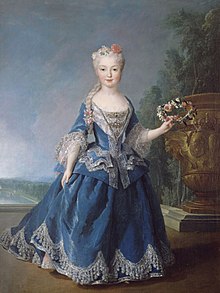Mariana Victoria of Spain
| Mariana Victoria of Spain | |||||
|---|---|---|---|---|---|
Barraca Real of Ajuda, Lisbon, Portugal | |||||
| Burial | 17 January 1781 , Lisbon, Portugal | ||||
| Spouse | |||||
| Issue | |||||
| |||||
| House | Bourbon | ||||
| Father | Philip V of Spain | ||||
| Mother | Elisabeth Farnese | ||||
| Signature | |||||
Mariana Victoria of Spain (
Early life
Mariana Victoria was born at the
Engagement to Louis XV

After the

According to the mother of the Régent,
Her establishment in France was not to be. Under the influence of the Prime Minister
Crown Princess of Portugal
Her arrival in Spain was taken as a great insult and caused a diplomatic rift between Spain and France. The offended Spanish soon after concluded a treaty with
Mariana and Joseph would soon have a close relationship. The couple enjoyed hunting as well as music – Mariana Victoria was an accomplished singer – they patronized Italian opera singers and the theatre but were both passionately religious. Despite this, her husband maintained various mistresses much to the dislike of his strong-willed wife. During her marriage, Mariana Victoria gave birth to eight children, four of whom survived infancy.
Queen and regent
At the death of her father-in-law,
In 1759, the Távora affair emerged after an assassination attempt on her husband failed and the powerful Távora family were, in the eyes of Pombal, completely responsible for the attack. Pombal later ordered the execution of all members of the noble family and it was only at the intervention of Mariana Victoria and her daughter, the Princess of Brazil, that some women and children were spared. As Pombal was de facto ruler of the state, Mariana Victoria and her husband took a less prominent role in politics.
Her husband, having suffered from a series of strokes, decided to allow his wife to take his place as head of government.[9] As such, Mariana Victoria was created Regent of Portugal in her husband's name. Created Regent on 29 November 1776, she remained so until her husband's death on 24 February 1777.[9] Upon her husband's death, their eldest daughter became the first queen regnant as Maria I. Throughout Maria I's reign Mariana Victoria exerted significant influence on her daughter, who would often ask her mother's advice on matters of state. In the early days of Maria I's reign, Pombal was exiled to the country.[9]
Queen dowager

When her daughter had assumed government, Mariana Victoria took it upon herself to improve relations with her native Spain, which was ruled by her older brother
Legacy

She was the godmother of
Issue
- Maria Francisca Isabel Rita Gertrudes Joana (17 December 1734 – 20 March 1816), married her uncle Infante Peter of Portugal and had issue. Later Queen regnant of Portugal.
- Maria Ana Francisca Dorotea Josefa Antonia Gertrudes Rita Joana Efigenia (7 October 1736 – 6 May 1813), potential bride for Louis, Dauphin of France, but her mother refused to consent to the marriage, died unmarried.
- Stillborn daughter (February 1739).
- Maria Francisca Doroteia Josefa Antónia Gertrudes Rita Joana Efigénia de Braganca (21 September 1739 – 14 January 1771), potential bride for Philippe Égalitébut she refused to marry him, died unmarried.
- Stillborn son (7 March 1741).
- Stillborn son (15 October 1742).
- Stillborn son (May 1744).
- Infante Joseph, Prince of Beira, no surviving issue.
Ancestors
| Ancestors of Mariana Victoria of Spain Elisabeth Amalie of Hesse-Darmstadt | |||||||||||||
|---|---|---|---|---|---|---|---|---|---|---|---|---|---|
References
- ^ Armstrong, p 243
- ^ a b c François Velde (4 July 2005). "The Abdication of the throne of Spain by Felipe V (1724)". heraldica.org. Retrieved 25 September 2010.
- ^ Pevitt, p 288
- ^ Pevitt, p 284
- ^ Armstrong, p 264
- ^ Armstrong, p 265
- ^ Maria Ana Vittoria Infanta de España in: Genealogy Database by Herbert Stoyan Archived 8 February 2015 at the Wayback Machine [Retrieved 7 January 2015].
- ^ Roberts, p 53
- ^ a b c Roberts, p 51
- ^ Roberts, p 65
- ^ Roberts, p 62
- ^ Genealogie ascendante jusqu'au quatrieme degre inclusivement de tous les Rois et Princes de maisons souveraines de l'Europe actuellement vivans [Genealogy up to the fourth degree inclusive of all the Kings and Princes of sovereign houses of Europe currently living] (in French). Bourdeaux: Frederic Guillaume Birnstiel. 1768. p. 8.
Bibliography
- Armstrong. Edward: Elisabeth Farnese: The Termagant of Spain, 1892
- Myrl. Jackson-Laufer. Guida: Women rulers throughout the ages: an illustrated guide, ABC-CLIO, 1999, ISBN 978-1-57607-091-8
- Pevitt. Christine : The Man Who Would Be King: The Life of Philippe d'Orléans, Regent of France, Phoenix, London, 1997, ISBN 978-0-7538-0459-9
- Roberts. Jennifer: The Madness of Queen Maria: The Remarkable Life of Maria I of Portugal; Templeton Press, London, 2009, ISBN 978-0-9545589-1-8
External links
![]() Media related to Mariana Victoria of Spain at Wikimedia Commons
Media related to Mariana Victoria of Spain at Wikimedia Commons
